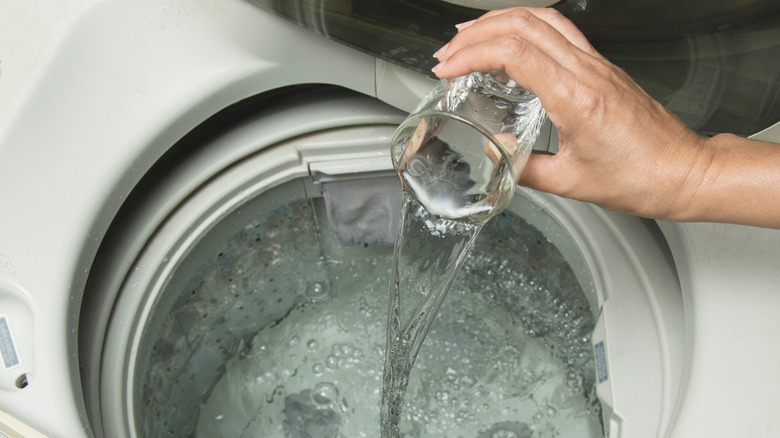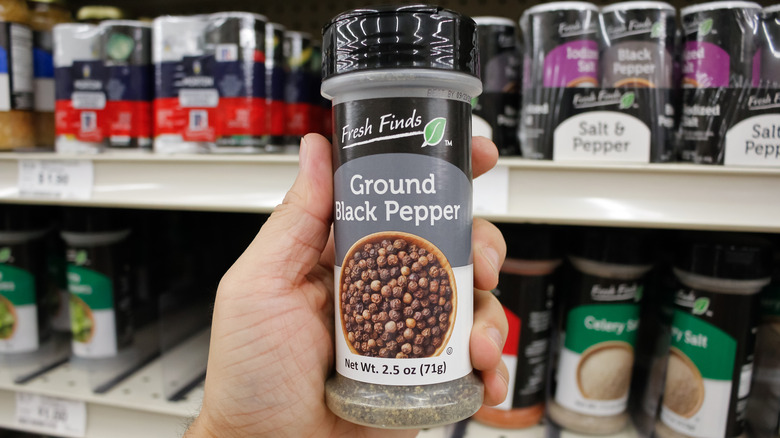Pantry Staples That Will Keep Your Clothes Bright (And Which To Avoid)
The color of fabric fades over time; it's one of those unfortunate realities. Between regular use, exposure to weather, and build-up of body oils, detergent, and fabric softeners, it's inevitable. And it's especially distressing if you have a beloved bright yellow shirt or cerulean blue skirt that you'd hate to lose. The best method of defense against fading is all about prevention. To keep your fabric colors bright, wash clothes on a cold, delicate cycle, only load them with similar fabrics (don't toss the towels in!) and like colors, and use a gentle, color-safe detergent. There are also some easy remedies that can help combat fading and color loss.
Before you go out and buy a product that promises to be a miracle worker, take a scan of your food cupboard. When you look over nearly any laundry guide to preserving and restoring color to your favorite fabrics, two ingredients come up time and time again: white vinegar and salt. More recently, black pepper has also been listed as a great alternative. While we can make the case for both vinegar and salt, we are having a tough time believing the hype around placing ground black pepper in the washing machine.
Vinegar and salt is a classic cleaning combo
Most color fading is due to physical abrasions thanks to daily wear and tear or sun fading. Further, even though laundry detergent gets our clothes clean, it can actually leave a residue behind that may dull fabrics, which you can clearly see come off in laundry stripping tutorials. Instead of resorting to a bunch of harsh chemicals, you may be better off using white distilled vinegar to remove residue. Because detergent is alkaline with a typical pH of 7 to 10, the highly acidic white vinegar may be able to counteract some of those base particles due to a chemical reaction, leaving you with cleaner clothing. With that being said, if used at the same time, the alkaline detergent and acidic vinegar will just cancel each other out, so only use vinegar during the wash or rinse cycle. Less is more when it comes to vinegar, so only add a few tablespoons at most.
Salt is also a solid choice to toss into the tumbler because of its unique composition. Salt is neutral, which means that it can be used with both alkaline detergent and acidic vinegar. It's also a natural abrasive and can be used to remove stains and buildup without causing significant damage to the fabric. However, it is mostly agreed that salt works better as a preventative measure to color bleeding than as a color reviver.
Don't season your laundry with black pepper
Just because salt has its place in your cleaning routine doesn't mean that its culinary companion, black pepper, does. Some claim that just tossing a tablespoon of black pepper into your washer during a regular cycle can brighten fabrics. When we first heard about this viral hack, we assumed there must be some chemical reaction or even centuries-long use of the spice in the laundry. But alas, it seems to be more like one of those things that spread like wildfire as people look for natural and affordable ways to keep their clothes looking great. Instead, black pepper only offers one potential laundry benefit, which is gentle exfoliation.
In an interview with The Kitchn, laundry expert Melissa Maker says of the black pepper hack, "We've been in this space for years, and this is definitely one of the most bizarre and misguided cleaning hacks that we've ever heard!" Without mincing words, Maker adds that the only real benefit black pepper would have in the wash would be as an abrasive, and abrasives are ultimately useless at restoring color; after all, you can't scrub extra color into clothes. But perhaps worst of all, you might be left with pepper-spotted clothing in the end, as washing machines aren't meant to take on your spice cabinet. So when it comes to pantry staples that keep fabrics looking bright, skip the pepper.


